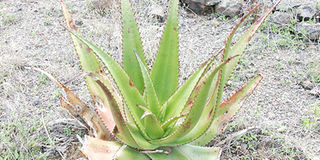Aloe vera growing takes root in Kenya

Earnings from aloe vera production have increased due to high demand of the plant’s extracts for health uses. Photo/FILE
Aloe vera growing is being commercialised in Kenya as demand grows for the plant’s extracts which are used in the manufacture of healthcare products.
The plant is also being used to fight poverty in arid and semi-arid regions with farmers assured of steady income.
According to Herbal Garden Ltd, the commercial arm of the Kenya Aloe Vera Growers Association, the nascent sector is maturing fast with more farmers in Eastern, Central and Rift Valley provinces venturing into its production because of high returns.
The company has moved further to add value to extracted gel for juice and capsules besides soap and lotions among skin care products for local sale.
Emerging crop
“The Government has recognised aloe’s potential as an emerging crop and we are working closely with the Agriculture ministry extension officers to help farmers,” said the company’s technical director Sospeter Njenga.
He said farmers are being trained on the plant’s cultivation and the proper species to be grown. Mr Njenga added that those who have been growing aloe over a long period are now selling its seedlings to new farmers who want to diversify their sources of income.
The export of medical products was banned in 1980s by then President Moi leading to the neglect of aloe vera. It was then left to grow wild under protection of the Kenya Wildlife Services.
The ban did not, however, prevent illegal aloe harvesting and smuggling rings finding their way to international markets. Global aloe raw material and products trade exceeds $120 million.
Former Jomo Kenya University of Agriculture and Technology Vice Chancellor Henry Thairu said local aloe growing has great potential because the crop is already being commercially cultivated for its gel with the US being the major producer followed by Venezuela and Mexico.
“Kenya has a growing market for organic health products though local businesses need help to tap into it,” said Prof Thairu.
Herbal Garden markets aloe vera juice, which serves as a herbal tonic used to boost the body’s immunity, at Sh1,000.
According to Kieni Aloe Vera Growers Association, the crop is a tool for fighting poverty as it has diversified and steady sources of income for farmers. There is also great potential for increased production.
“One acre of aloe requires about 4,000 plants from which one may harvest three to four leaves per plant at the first harvest 18 to 24 months after planting,” said Mr Gerald Thuo a member of the Kieni association.
Thereafter, a farmer harvests every three months. Each leaf weights 2 kilogrammes and is priced at Sh30 per kilogramme. The producer can earn Sh960,000 for each harvest totalling to about Sh3.8 million a year.
When harvesting the leaves sliced close to the plant are immediately placed with the cut end facing downwards in a v-shaped wooden trough to allow the juice to trickle rapidly into a vessel placed beneath.
Among the problems facing farmers, Mr Njenga said, are procuring aloe leaf extractors, special juicers, vacuum filtration units, homogenizers and packing units among other machines which are too expensive as they cost over Sh20 million to be imported.
Tax waivers
“The Government has to consider granting tax waivers to allow farmers to import these machines because trade in aloe products is a multi-billion shilling industry globally,” he said.
Kenya last year published the Aloe Utilisation Guidelines and Strategy which seeks to provide opportunities for better market access to both producers and processors.
The aim was to bridge the policy gap to jump-start commercial planting of the crop after the 1986 government decree banning harvesting of the plant from the wild.
Value chain
Speaking during the strategy launch, Forestry and Wildlife Minister Noah Wekesa said there is need for co-operation in conserving, managing and sustainably utilising aloe and in enhancing the value chain.
The strategy seeks to domesticate regional and international agreements, treaties and conventions in respect to crop utilisation, improvement of stakeholders capacity and transfer of appropriate technologies to traders and farmers.




